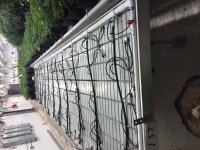bsgospel
Bat Macumba
You'll have to do some version of a flush. If the pH is high, flush with gypsum. If it's something else I'm sure someone smarter than me will be able to identify it and give guidance. I could be wrong but from the pics of good looking plants (pic 1) I already see a potassium issue that jidoka has cited in the past. It's the ever so slightly burnt tip on the fan leaves. Your numbers make sense statically but if there was an issue from the get go, ...I don't know what to tell you...






